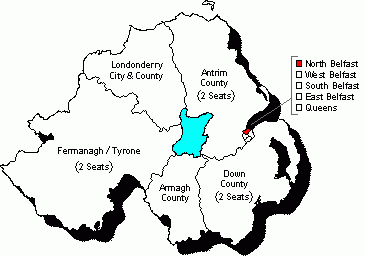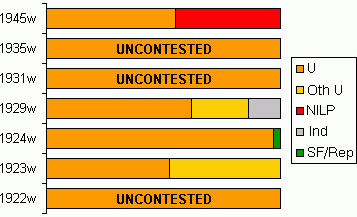

 |

|
| |
|
|
Friday April 4, 2025
|

|

|

|
| Map and diagram by Conal Kelly | ||
Incorporating the northern quarter of the city of Belfast, this constituency was established under the terms of the Government of Ireland Act 1920. The original North Belfast constituency had been eliminated as a result of the 1917 Redistribution of Seats (Ireland) Act. This new constituency replaced the short-lived Westminster seats of Duncairn and Shankill. Between 1922 and 1949 the constituency was represented by three different MPs, all of whom were Unionist. The longest serving of these was Thomas Somerset, who was first elected in 1929 and continued to represent the constituency until his retirement in 1945. The general elections of 1922, 1931 and 1935 went uncontested. The declared winner in each case was the sole Unionist nominee. The constituency had the lowest turn-out across Northern Ireland in the 1923 general election.
See also election results for North Belfast 1950-1970, 1973-1982, 1983-1992 and 1993-2007.
| U | Ind U | Ind | NILP | SF/Rep | |
| 1945w | 55.3% | 44.7% | |||
| 1935w | * | ||||
| 1931w | * | ||||
| 1929w | 62.1% | 24.4% | 13.5% | ||
| 1924w | 96.6% | 3.4% | |||
| 1923w | 52.5% | 47.5% | |||
| 1922w | * |
* The only candidate nominated for the 1922 and 1923 General Elections was Unionist Thomas McConnell. The only candidate nominated for the 1931 and 1945 General Elections was Unionist Thomas Somerset. In each instance the sole candidate was therefore duly elected without a contest.
Unionist majority: 4,916; electorate: 73,321; votes cast: 63.6%
Following the
retirement of Somerset, William Frederick Neill was selected by the
Unionist Party to defend the North Belfast seat. Neill would face
opposition from the NILP in the form of William Leeburn. In what was
one of the closer results of the election, Leeburn managed to come
within 5,000 votes of his opponent. Despite the reduced majority, Neill
was returned as the member of parliament for North Belfast.
Neill had previously been elected to Belfast Corporation in 1938 and
would serve as Mayor between 1946 and 1949. Leeburn stood unsuccessfully
for the Northern Ireland House of Commons in South Tyrone in a 1945 by-election
and in Belfast Willowfield in the 1949 general election. He would also
unsuccessfully contest the North Belfast seat again in the
1950 Westminster
elections.
Unopposed Unionist Candidate.
As was the case in 1929, Somerset was the sole candidate nominated in North Belfast and was duly elected without a contest once more. North Belfast was one of seven seats that went uncontested in the 1935 general election in Northern Ireland. The sole nominee (and hence winner) in each instance was the Unionist candidate.
Unopposed Unionist Candidate.
In 1931, Somerset was the sole candidate for North Belfast and was duly elected without a contest. North Belfast was one of nine constituencies across Northern ireland that went uncontested in 1931. The successful candidate in each case was representing the Unionist Party.
Unionist majority: 16,903; electorate: 61,438; votes cast: 72.9%
Following McConnell's
retirement, the Unionist Party selected Thomas Somerset to defend the seat.
Somerset faced two opponents in this his first electoral contest. Tommy
Henderson, who had conested the seat in 1923, was once again standing as an
Independent Unionist. Also standing was David Wilson on a Local Optionist
ticket (seeking the prohibition of alcohol sales). In the end, despite a
reduced majority, Somerset was returned with 62% of the vote.
In the 1925 Northern Ireland general election, Henderson had topped the
poll in the four-seat North Belfast constituency. He later switched to
the newly created, single-seat Belfast Shankill constituency in the 1929
election.
Unionist majority: 32,990; electorate: 46,902; votes cast: 75.4%
In this, the
third election in as many years, McConnell would face a new opponent
in the form of Sinn Fein candidate Hugh Corvin. In one of the largest
turn-outs of the election, McConnell won comfortably, securing just
under 97% of the vote.
At the time of the election Corvin was incarcerated, having been
arrested and interned for IRA membership in 1923. Corvin would
later unsuccessfully contest the 1943 West
Belfast by-election as an Independent Republican.
Unionist majority: 1,600; electorate: 46,844; votes cast: 68.2%
Unlike the 1922 election,
McConnell faced opposition in defense of his seat in 1923. North Belfast was
one of only three constituencies contested across Northern Ireland. His opponent
was Independent Unionist Thomas Henderson. In what was the closest result of
the election, McConnell edged past Henerson with a majority of 1,600. At 68.2%,
North Belfast had the lowest turn-out of the three contested constituenies in
the 1923 general election.
Henderson was a founding member of the Ulster Unionist Labour Association (UULA)
in 1918. He resigned from the Unionist Party in 1920 amd was elected as an I
ndependent Unionist to Belfast City Council in 1923. He was also elected to the
Northern Ireland parliament in 1925 for North Belfast (4 seats) and for Belfast
Shankill from 1929 to 1953.
Unopposed Unionist Candidate.
This was the
first election for the newly established North Belfast constituency.
The new constituency replaced the Belfast Duncairn and Belfast Shankill
constituencies that had been used in the 1918 election. Thomas McConnell
had been previously elected to represent Duncairn in the 1921 by-election.
As the sole nominee in this election he was duly elected without a contest
for North Belfast.
McConnell had also been previously elected to Belfast Corporation.
See also:
Results from 1922 to 1949 for each seat: East Belfast | North Belfast | South Belfast | West Belfast | Antrim | Armagh | Down | Fermanagh and Tyrone | Londonderry | Queens University
Other sites based at ARK: ORB (Online Research Bank) | CAIN (Conflict Archive on the INternet) | Northern Ireland Life and Times Survey
Your comments, please! Send an email to me at nicholas.whyte@gmail.com.
Conal Kelly, 10 October 2007.
|
|
Disclaimer:©
Nicholas Whyte 1998-2004 Last Updated on Wednesday, 12-Jan-2005 12:12
|